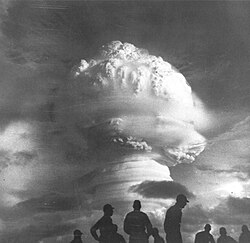Beruina Atoll nuclear disaster
 UCSS soldiers watch the mushroom cloud of the detonated bombs | |
| Date | April 9th, 1959 |
|---|---|
| Location | Beruina Atoll, southeastern Cantalle Ocean |
| Deaths | 1,000+ |
The Beruina Atoll nuclear disaster occured on April 9th, 1959, when a UCSS bomber crashed onto Beruina Atoll in the southeastern Cantalle Ocean, roughly 400 miles west of the Annaskermishilles, causing the four atomic weapons aboard to detonate. The UCSS had been conducting nuclear tests on islands throughout the region during the 1950s, and the plane was transporting the bombs for scheduled tests on islands near Antartique. At some point during the flight, the plane suffered mechanical failure and the crew attempted to make an emergency landing on the atoll. The plane crashed, however, and the ensuing explosion of the bombs aboard killed nearly all of the 1,000 indigenous inhabitants of the island and destroying all standing structures. This incident, along with the accidental detonation of another weapon in Antartique two months prior, caused massive international condemnation against the UCSS for their weapons program, and UCSS massively scaled back both their development and testing of weapons in the atmosphere. The disaster and its effects inspired the 1982 Treaty of Forgeheim, which aimed regulate the possession and use of nuclear weapons. The incident was also the deadliest nuclear disaster until the 1992 Treviso disaster.